French Connection: Appreciating Rafael Nadal’s First 11 Roland Garros championships
By Matt Fitzgerald May 20, 2019Was the Carlos Alcaraz-Jannik Sinner Roland Garros match the best ever played?
By Steve Tignor Jun 13, 2025Who were the winners and losers at 2025 Roland Garros?
By Pete Bodo Jun 09, 2025Carlos Alcaraz and Jannik Sinner played the match of the decade, and maybe the century, at Roland Garros
By Steve Tignor Jun 09, 2025PHOTOS: Carlos Alcaraz captivates Chatrier with trademark joy after improbable Roland Garros title defense
By TENNIS.com Jun 09, 2025Carlos Alcaraz saves three match points, tops Jannik Sinner in longest Roland Garros final of Open Era
By TENNIS.com Jun 08, 2025Aryna Sabalenka clarifies controversial Coco Gauff claim: "Can't pretend it was a great day"
By TENNIS.com Jun 08, 2025Coco Gauff counters Aryna Sabalenka's Roland Garros claim by saying she 'wanted' Iga Swiatek in final
By TENNIS.com Jun 08, 20252025 Roland Garros men's final preview: Carlos Alcaraz vs. Jannik Sinner
By Steve Tignor Jun 07, 2025PHOTOS: Coco Gauff celebrates Roland Garros title with parents, toasts champagne at Tennis Channel set
By TENNIS.com Jun 07, 2025French Connection: Appreciating Rafael Nadal’s First 11 Roland Garros championships
The most impressive wins, and closest calls, from the King of Clay's title runs on the terre battue.
Published May 20, 2019
Advertising
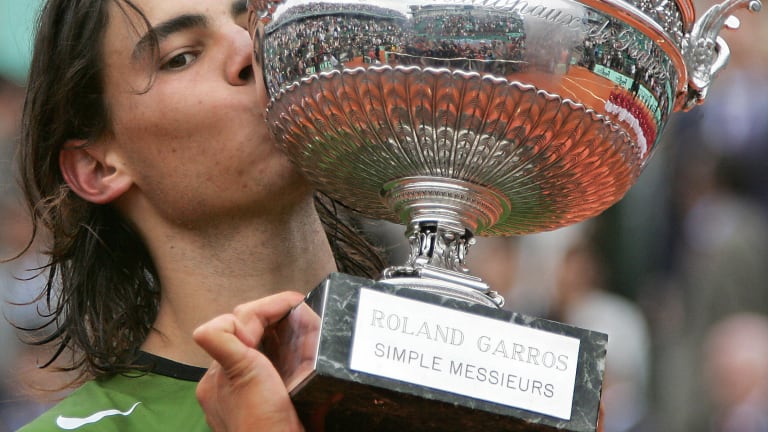
No. 1: 2005
© AFP/Getty Images
May 23: a poised prodigy takes No. 1 Court for the first—and last—time at Roland Garros, in his debut against Lars Burgsmuller. A sleeveless shirt and pirate pants characterize Rafael Nadal’s teenage style, but the Spaniard commands a strategic, powerful presence well beyond his years. Nadal would dismiss Burgsmuller in straight sets, and in turn, ushered in a new era of clay-court tennis. On his 19th birthday, Nadal upstaged Roger Federer in the semifinals before claiming his first Grand Slam title over Mariano Puerta, completing a stellar spring that included titles in Monte Carlo, Rome and Barcelona to go with a 24-match clay-court win streak.
Most Impressive win: Semifinals; Nadal d. Federer, 6-3, 4-6, 6-4, 6-3
They had met before, trading victories in Miami (2004-05), but the magnitude of this moment was far greater, with both seeking to reach their first French Open final. Top-ranked Federer opened a 3-1 lead in the fourth set before Nadal ran off the final five games to win the first of many Grand Slam meetings to come.
Closest call: Final; Nadal d. Puerta, 6-7 (6), 6-3, 6-1, 7-5
Playing for his first Slam title, Nadal was already in unfamiliar territory: fellow left-hander Puerta won a tiebreaker to put Nadal in a one-set deficit for the first time. Nadal saved three set points with Puerta serving at 5-4 in the fourth set, and relied on his incredible instincts and endless energy to become the first teen since Pete Sampras (1990 US Open) to lift a major singles trophy.
Advertising
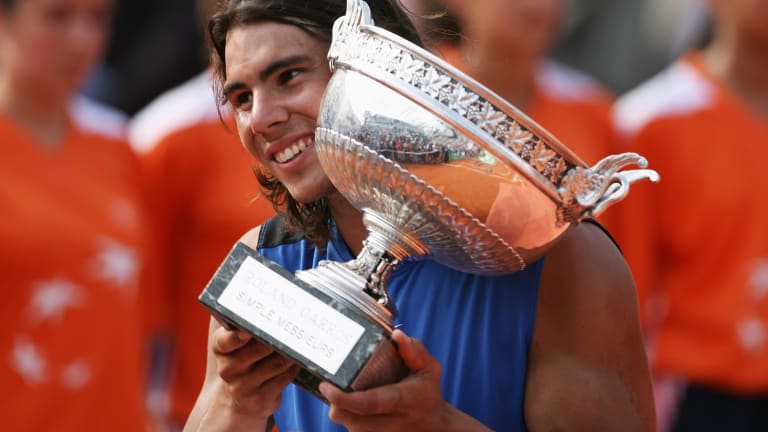
No. 2: 2006
© Getty Images
A different kind of pressure surrounds a player when entering an event as defending champion. When you haven’t lost on a surface in 53 matches, every challenger yearns to be ‘the one’ who ends your reign. Nadal undoubtedly felt the added weight on his shoulders and in his legs at the Paris major in 2006. Counterpunchers Paul-Henri Mathieu and Lleyton Hewitt provided periods of discomfort for the second seed to decipher, and those experiences would boost Nadal in his rematch with Federer. Nadal swiftly put Federer’s impeccable start in the title match behind him, improving his unbeaten run on the red dirt to 60 matches.
Most impressive win: Third round; Nadal d. Mathieu, 5-7, 6-4, 6-4, 6-4
From a feisty Frenchman to a stubborn banana peel, everything was thrown Nadal’s way on the first day of his 20s. Mathieu, a former junior champion, played tug of war with the birthday boy for four hours and 53 minutes–93 of those in the first set alone. By the end, Nadal’s precision and variety tipped the scale to surmount Mathieu’s heavy hitting and home-crowd advantage.
Closest call: Final; Nadal d. Federer, 1-6, 6-1, 6-4, 7-6 (3)
Four weeks prior, Nadal edged Federer to win an instant classic final in Rome. Aiming to be the first man since Rod Laver to hold all four major titles simultaneously, Federer came out blazing with pinpoint accuracy, but Nadal pounced on the Maestro’s dip in form to take control. A possible fifth set loomed when Federer broke for 5-5 in the fourth, except Nadal had plans to finish writing this chapter, putting pen to paper with a commanding tiebreak performance for his sixth victory in seven meetings with the Swiss.
Advertising
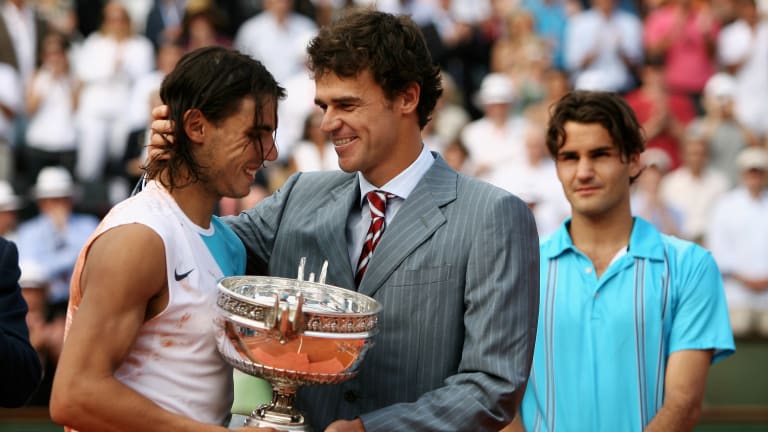
No. 3: 2007
© 2007 Getty Images
Nadal was still the clear-cut favorite in Paris–but no longer held the title of invincible–after Federer ended Rafa's 81-match win streak on clay in Hamburg. That loss would prove to be nothing but a blemish on Nadal’s immaculate resume. One by one, each opponent was swept aside, and Nadal advanced to the final without conceding a set for the first time. Another clash of the titans with Federer soon followed; when it was over, Nadal entered the record books by joining Bjorn Borg as the only man to win three French Open titles in a row since 1914.
Most impressive win: Semifinals; Nadal d. Djokovic, 7-5, 6-4, 6-2
Novak Djokovic was a budding star–and one of Nadal’s earlier-season conquerors in a remarkable run to the Miami crown. Nadal took their next encounter in Rome and replicated that same authority at Roland Garros, never letting Djokovic settle into his first Grand Slam semifinal with a 48 percent success rate against the Serbian’s serve.
Closest call: Final; Nadal d. Federer, 6-3, 4-6, 6-3, 6-4
Act III saw different plot points carried out between Nadal and Federer yet concluded with the same end scene: a four-set victory. Federer hoped securing his first clay-court win over Nadal would foreshadow a flip of the Paris script. On this day, Nadal came up clutch when he was pressured, saving 16 of the 17 break points he faced (including all 10 in the opening set) en route to his fifth title of the year.
Advertising
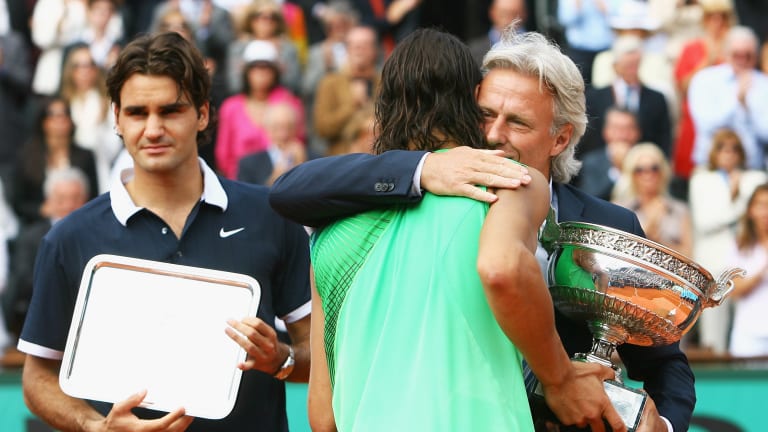
No. 4: 2008
© 2008 Getty Images
What word describes Nadal’s mood at the crown jewel of the clay season in 2008? Hangry. For the first time in Paris, Nadal entered on the back of defeat, having gone down to countryman Juan Carlos Ferrero in his Rome opener. Was his Roland Garros run vulnerable? That question was answered with a resounding no. With Rome firmly in Nadal’s rear-view mirror, he showed no leniency, devouring every challenger in his pathway. Surrendering just 41 games over 21 sets, this was Nadal’s most dominant fortnight by far and cemented his moniker as the King Of Clay.
Most impressive win: Final; Nadal d. Federer, 6-1, 6-3, 6-0
Ruthless all tournament long, Nadal saved his very best for last. Passing shot lasers, baseline wizardry and steady serving were all dialed up to the max in a clinical performance where Hurricane Rafa handed Federer the worst Grand Slam defeat of his career. Nadal equaled Borg’s Open Era record of four consecutive French Open titles and furthered his claim as the best in the world, later substantiated after toppling Federer in the 2008 Wimbledon final in what many consider the greatest match of all time.
Closest call: Semifinals; Nadal d. Djokovic, 6-4, 6-2, 7-6 (3)
No player was able to win a set off Nadal. In fact, 2008 Australian Open champion Djokovic was the only competitor to force a tiebreaker after Nadal failed to serve out their semifinal at 5-4 in the third set. Unfazed, Nadal raced out to a 6-0 lead and sealed his fourth match point with an overhead winner for his 27th straight Roland Garros victory.
Advertising
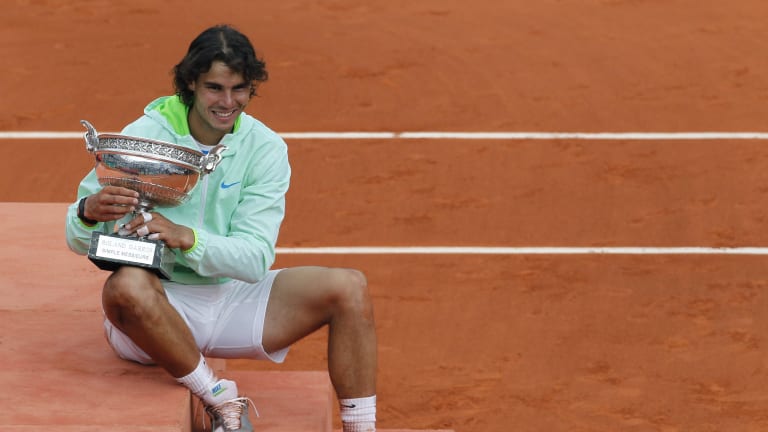
No. 5: 2010
© AFP/Getty Images
Hello from the outside. This was new terrain for Nadal, having suffered his first Roland Garros defeat at the hands of Robin Soderling a year earlier. With the gravity of an undefeated record no longer pulling Nadal down, the four-time titlist flew in cruise control much like he did two years earlier. He wasn’t quite as merciless in these 21 sets, but his passion still burned ferociously, setting fire to the rain of 2009. Nadal tripped up Soderling with his defensive flair to reclaim his throne, as well as the No. 1 ranking from Federer.
Most impressive win: Final; Nadal d. Soderling, 6-4, 6-2, 6-4
There was amplified anticipation for this final, but Nadal made sure his rematch with Soderling was a one-sided affair. Not wanting history to repeat itself, Nadal was uncompromising in chasing every shot. His scrambling seeped under Soderling’s skin, and his seamless transition from defense to offense minimized the big-hitting Swede’s ability to play on the terms that propelled him to victory the previous year. Nadal produced a new record: the first to sweep the four principal clay-court titles in Monte Carlo, Madrid, Rome and Paris.
Closest call: Quarterfinals; Nadal d. Almagro, 7-6 (2), 7-6 (3), 6-4
Nicolas Almagro, an excellent clay-courter himself, took a set off Nadal in their earlier Madrid semifinal. That result provided the fellow Spaniard a jolt of confidence he lacked when mustering a single game in each set against Nadal in the same Roland Garros stage two years prior. Almagro opened with a quick break advantage, though Nadal found his footing shortly thereafter, and was the sturdier of the two men in the moments that mattered.
Advertising
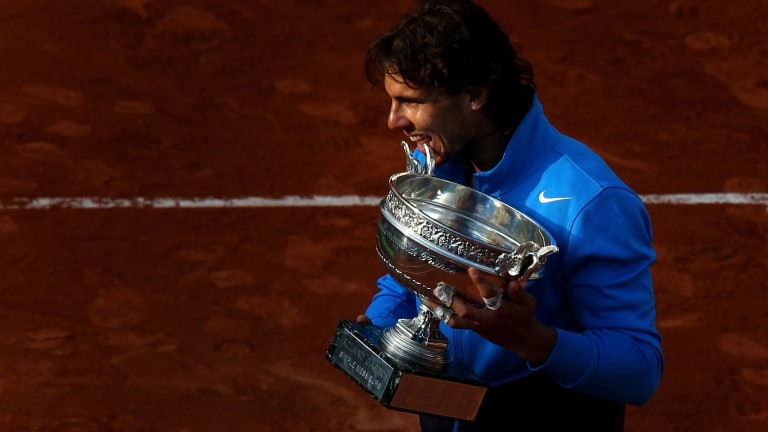
No. 6: 2011
© 2011 Getty Images
Nadal’s journey towards matching Borg’s major milestone in Paris would require clear conviction in his game. He was on the losing end of four finals in 2011, all against a resilient Djokovic, who arrived in Paris with a 37-0 season start. Nadal’s voyage this fortnight began with his longest French Open first-round match, a four-hour test from John Isner and ended with meeting a reinvigorated Federer. As Federer’s final forehand sailed long, Nadal dropped to his knees, now in Borg’s company with six Roland Garros trophies and the newest member the double-digit major club.
Most impressive win: Final; Nadal d. Federer, 7-5, 7-6 (3), 5-7, 6-1
Federer was riding high, having ended Djokovic’s perfect season in the semifinals, and sustained that belief to start the championship clash. With Federer serving at 5-2, Nadal proceeded to reel off seven straight games, saving a set point in the process, and would open a hard-fought two set, 4-2 lead. Federer made one last stand, digging his heels in to snatch the third set. Like he’s demonstrated so often, Nadal hit the reset button, punishing short balls and drawing errors from his frustrated foe to win the first major final between two men holding Career Grand Slams.
Closest call: First round; Nadal d. Isner, 6-4, 6-7 (2), 6-7 (2), 6-2, 6-4
Nadal had never played a five-setter at the French Open, until now. Despite an inability to break Nadal’s serve, it was Isner who stepped up to the plate to seize two straight tiebreakers. Remarkably, the world No. 1 responded by winning the fourth set without striking an unforced error and wore down the American in classic Nadal fashion.
Advertising
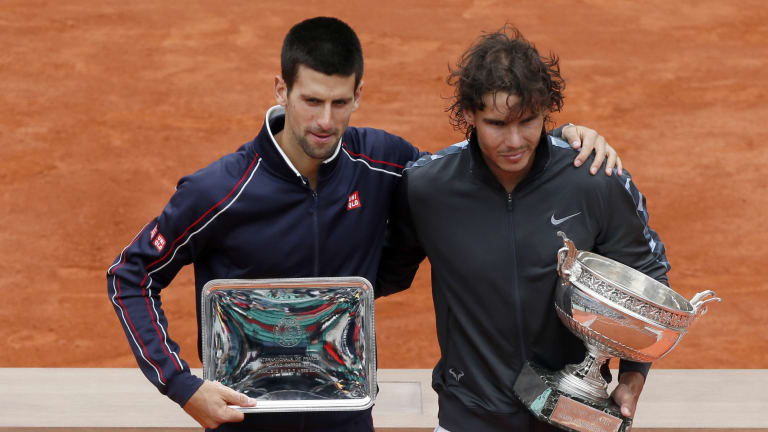
No. 7: 2012
© AFP/Getty Images
Since hoisting the La Coupe des Mousquetaires the previous year, Nadal abruptly found himself playing second fiddle to Djokovic. The Serb outfoxed Nadal in the next three major finals, culminating with the longest tilt a Grand Slam final had ever witnessed at the Australian Open. A return to the red dirt refreshed Nadal, snapping a skid of seven successive losses to Djokovic (all finals) in Monte Carlo. Nadal won again in Rome to set the scene for Paris, and it was no surprise to see the pair meet on championship Sunday. With history on the line for both men, Nadal proved Court Philippe Chatrier was still his kingdom, becoming the tournament’s Open Era men’s title leader.
Most impressive win: Final; Nadal d. Djokovic, 6-4, 6-3, 2-6, 7-5
Nadal generated notable routs over Juan Monaco in the round of 16 and David Ferrer in the semifinals, but clearing the mental barrier by vanquishing Djokovic on the Grand Slam final stage was most compelling. A seventh title seemed well within reach, however Djokovic—playing with nothing to lose after going down two sets and 2-0—ascended with intensified aggression to claim the next eight games. A second rain delay pushed play to Monday, and when the players returned, it was advantage Nadal. The second seed immediately broke back, and his execution for the duration was a notch above Djokovic, who ultimately double-faulted to end his bid.
Closest call: Final; Nadal d. Djokovic, 6-4, 6-3, 2-6, 7-5
It took 21 sets for someone to get the best of Nadal. For Djokovic, the third set was indicative of the audacious, assertive play that guided him to the top of the ATP rankings and a shot at capturing four consecutive Grand Slam titles.
Advertising
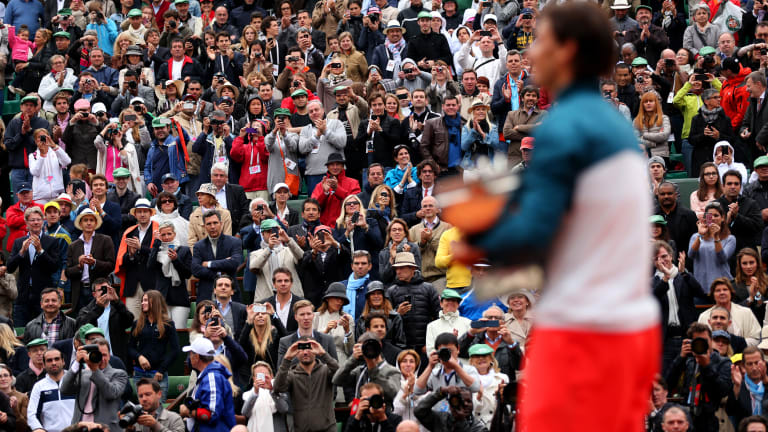
No. 8: 2013
© 2013 Getty Images
Stade Roland Garros was the last place Nadal experienced jubilation in 2012, as a left-knee injury sidelined him for seven months following Wimbledon. His return was nearly note-perfect; he came to Paris on a 15-match win streak. The three-time defending titlist was promptly pressed by unlikely candidates he was playing for the first time, Daniel Brands and Martin Klizan, before his knee sat for its final examination in an enthralling semifinal with Djokovic. Like a boxing match, each traded blows and battled back from hefty bruising until Djokovic had endured enough, and Nadal transferred that punishing panache to an imperious final performance against Ferrer. On that June 9th, Nadal became the first men’s player in the Open Era to win the same major tournament eight times.
Most impressive win: Semifinals; Nadal d. Djokovic, 6-4, 3-6, 6-1, 6-7 (3), 9-7
Popcorn was popping for this one. Djokovic was the one man who beat Nadal in the European clay swing (Monte Carlo final) and Nadal responded with 20 consecutive wins. Reminiscent of their 2012 Melbourne epic, this collision brought plenty of ‘suffering’ through its grueling exchanges, sensational scrambling and plot twists that tugged at both hearts perpetually pouring out every ounce of passion on the court. Resembling two marathon leaders, the two pushed forward—and after four hours and 37 minutes, it was Nadal who reached the finish line first.
Closest call: Semifinals; Nadal d. Djokovic, 6-4, 3-6, 6-1, 6-7 (3), 9-7
Nadal was six points from exiting. An unfathomable miscue by Djokovic would change everything. Serving at 4-3, deuce, the Serb put away an overhead but stumbled, touching the net to concede the point. The consequences were monumental, as his lead soon evaporated and he found himself serving from behind.
Advertising
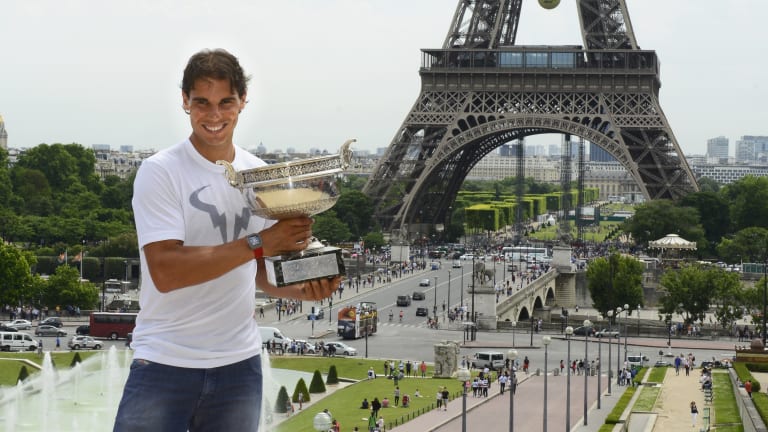
No. 9: 2014
© Getty Images
Nadal’s leadup to Roland Garros was his most topsy-turvy to date. The world No. 1 was stunned by countrymen Ferrer and Almagro in clay tune-ups, then regrouped to triumph in Madrid over Kei Nishikori before being outclassed by Djokovic in the Rome final. For the most part, that didn’t matter. It took a quarterfinal rematch with Ferrer for Nadal to experience tension. After quashing Andy Murray with ease, Nadal faced off against Djokovic for the third year running. The standard didn’t hit the benchmark of the previous year, with Djokovic regrettably double-faulting to conclude matters. The Nadal dynasty broke a tie with Max Decugis for an all-time record ninth French Open title.
Most impressive win: Semifinals; Nadal d. Murray, 6-3, 6-2, 6-1
Three weeks earlier in Rome, Murray collected the opening set 6-1 off Nadal. No one predicted the Brit would only amass the same number of games across three sets in Paris. Nadal refused to let up from start to finish, reprimanding Murray’s passive play with a barrage of attacks. He was aggressively accurate with 24 winners to 12 unforced errors in the one-hour-and-40-minute rout.
Closest call: Final; Nadal d. Djokovic, 3-6, 7-5, 6-2, 6-4
Djokovic brought a 35-0 record in finals when winning the first set, so when he locked up the opening set over Nadal, many wondered if this was finally his time to shine in Paris. He then erased a 4-2 deficit in the second set, but was unable to force a tiebreaker. Nadal scorched a down-the-line forehand winner to level the match and retained the hotter hand for the majority of the second half, improving his staggering stretch to 66 wins in 67 matches at the event.
Advertising
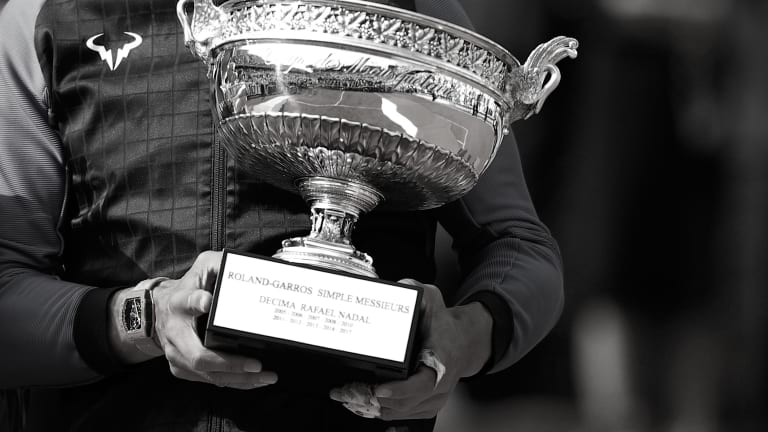
No. 10: 2017
© 2017 Getty Images
Three years removed from his last major title, Nadal was at last back as a formidable favorite. The Spaniard picked up hardware in Monte Carlo, Barcelona and Madrid to put his competitors on notice, and turned back the clock by the time he stepped onto Court Suzanne Lenglen for his first-round match with Benoit Paire. This was his homecoming, his emancipation, his testimony. Nadal cleared each hurdle with magnificent momentum, gaining velocity down the track as he sprinted past gifted clay-courters Dominic Thiem and Stan Wawrinka to clinch La Decima, his 10th French Open trophy. With the title, Nadal passed Pete Sampras for sole possession of second place on the all-time major title list with 15 triumphs.
Most impressive win: Final; Nadal d. Wawrinka, 6-2, 6-3, 6-1
Wawrinka was no stranger to showcasing his best tennis on spirited stadium courts, which included wins over Nadal in the 2014 Australian Open final and 2015 Rome quarterfinals, and against Djokovic in two Grand Slam finals–the 2015 French Open and 2016 US Open. There would be no responses to Nadal this time around, other than head turns and racquet claps. The distinguished clay professor put on his latest masterclass in deflating the shaky Swiss to become the first player in the Open Era to win a single Grand Slam event 10 times.
Closest call: Semifinals; Nadal d. Thiem, 6-3, 6-4, 6-0
Just three players managed to win four games in a set during Nadal’s 2017 run. Robin Haase posted the most overall games with eight in his third-round loss, though Thiem was expected to provide a much stronger challenge after taking down Nadal in the Rome quarterfinals.
Advertising
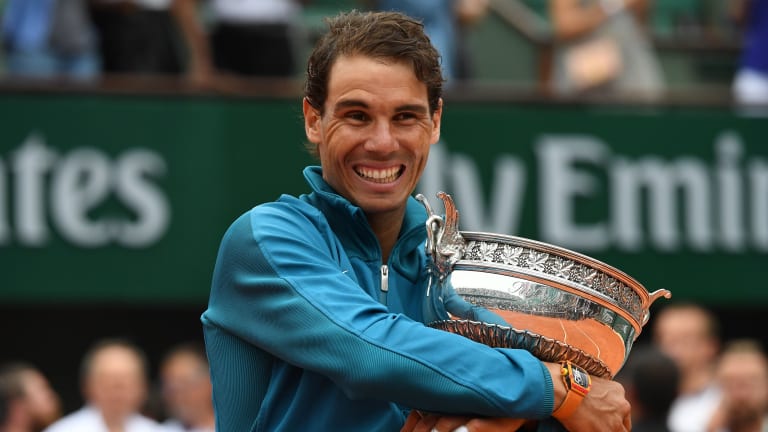
No. 11: 2018
© AFP/Getty Images
Away for nearly three months, Nadal’s patience in nursing a string of injuries paid dividends. Lifting crowns at three of the four European clay events he entered, Paris was feeling a sense of déjà vu when Nadal rolled into town. Much like the year before, Nadal found little resistance as he made his way into the second week. A peppery Diego Schwartzman required Nadal to work for his place in the semifinals by taking–and finishing– full, fearless cuts. After that, Nadal made the necessary repairs to manufacture his 11th title, blowing past Juan Martin del Potro and Thiem to increase his major haul to 17 trophies.
Most impressive win: Final; Nadal d. Thiem, 6-4, 6-3, 6-2
Different round, same story. Thiem was the only player to defeat Nadal on the dirt the past two seasons. But translating that success to best-of-five was a different animal, arguably the most difficult to conquer. The Austrian had a year to think about his 2017 Paris semifinal demolition to Nadal, and while enhancements elevated him to No. 4 in the world, Rafa augmented his genius by sending Thiem back to the drawing board with yet another clinical display.
Closest call: Quarterfinals; Nadal d. Schwartzman, 4-6, 6-3, 6-2, 6-2
A barrage of 20 winners from the 5’7’’ Schwartzman gave the Argentine a much deserved one-set lead. Rain played a pivotal role, twice in Nadal’s favor, in redirecting the trajectory of this match. Resuming from 3-2 down in the second set, Nadal broke and won three straight games before play was suspended for good. The following day, a thunderous Nadal fired on all cylinders, protecting serve and controlling court positioning, to finish off Schwartzman.